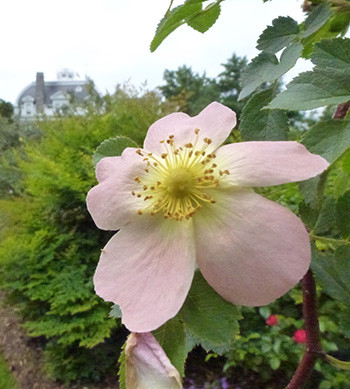
Plants of Week: May 29
With last week’s commencement, the tradition continued of graduating seniors each receiving a rose from the Dean Bond Rose Garden. Roses can be notoriously difficult to grow, and are plagued by many diseases and pests. Scott Arboretum grows hardy cultivars like ‘Lord Penzance’ which are less affected by these problems and easier to manage. ‘Lord Penzance’ is a climbing shrub found around the perimeter of the rose garden. The flowers are pale pink to yellow with five petals. The foliage has a strong, sweet scent, making it a great accent along the border of a bed. Photo credits: G. Wermeling
Syringa x presoniae ‘Nellie Bean’
While on the subject of good smells consider the ‘Nellie Bean’ lilac. Full-sized this can be a rather large shrub producing big panicles of sweet smelling lavender to rosy-pink flowers. Expect plenty of bees when this lilac blooms in May. This is a shrub that you want in a prominent place when it is at its prime. While you will find these shrubs on campus in the shadow of Pearson Hall’s east side, this cultivar is very heat tolerant so don’t be afraid of giving it more sunlight. Photo credits: G. Wermeling
Cladrastis kentuckea ‘Sweetshade’
Walking in the John W. Nason Garden you cannot avoid seeing all the flowers of Cladastris kentuckea ‘Sweetshade’. If you are planting this tree you have to know that you will find these flowers all over your garden, giving the impression that there was a recent snow flurry. These beautiful white blooms drift to the ground throughout the day while C. kentuckea is in bloom. These trees, commonly known as yellowwood, are fairly hardy, requiring little maintenance generally, although a strong, late frost could damage the blooms.
‘Sweetshade’ is a medium sized tree that likes full to partial sun. It provides good shade and has deep roots so you can grow many shade-tolerant plants underneath; try growing plants you think would look good accented with the white flowers of C. kentuckea when they fall. Photo credits: G. Wermeling








No Comments